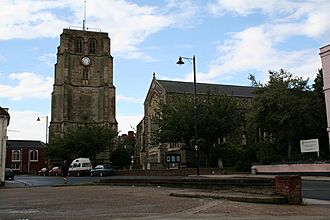Beccles bell tower facts for kids
Quick facts for kids Beccles bell tower |
|
|---|---|
 |
|
| General information | |
| Architectural style | Perpendicular Gothic |
| Town or city | Beccles |
| Country | England |
| Coordinates | 52°27′30″N 1°33′45″E / 52.4583°N 1.5625°E |
| Construction started | c1500 |
| Completed | 1540 |
The Beccles bell tower is a tall, stand-alone tower next to St. Michael's Church in the market town of Beccles, Suffolk, England. It's a very important historic building, known as a Grade I listed building.
This impressive tower stands on a cliff, looking over the River Waveney. It's about 97 feet (30 meters) tall and 30 feet (9 meters) wide at its base. The tower really stands out, overlooking the whole town and the beautiful Broads National Park. If you climb the 122 steps to the top, you can see amazing views. You can spot the Waveney River, the North Sea in the distance, and the flat lands of the Broads stretching into Suffolk and Norfolk.
Contents
Building the Beccles Bell Tower
How Was the Tower Built?
Building the tower started around the year 1500. Monks from Bury St Edmunds Abbey helped to guide the project. This abbey was a very important place for pilgrims in nearby Bury St. Edmunds.
Like St. Michael's Church itself, the tower is built in the Perpendicular Gothic style. This means it has tall, straight lines and large windows. The tower needed very strong foundations because it is so heavy. It has thick walls made from Roche Abbey stone and huge supports called buttresses. You can find a spiral staircase in each corner of the tower.
Why Is the Tower Separate?
Usually, bell towers (also called campaniles) are built right next to a church, often at the western end. However, the Beccles tower is different. It stands apart from the church, to the east. This was because of where it was built, right on the edge of a cliff. The tower is also incredibly heavy, weighing about three thousand tons! Building it separately made it more stable.
Local historians think the tower was meant to have a tall, pointed top, called a steeple or spire. But after 40 years of building, work stopped. This happened because of the Protestant Reformation during the time of King Henry VIII. This period brought big changes to Roman Catholic institutions, which affected the building project.
Amazing Craftsmanship
You can see incredible skill and care in how the tower was built. Look closely at the stone carvings, especially the detailed patterns and decorative spaces. The main entrance to the tower looks a lot like the south porch of the church. It shows the coats of arms of local families. These families, like the Garneys, Redes, and Bowes, gave a lot of money to help build the tower.
In 1586, a fire badly damaged the inside of St. Michael's Church. Luckily, the bell tower was not harmed at all.
Clocks and Bells
The Tower Clocks
In the early 1700s, two clock faces were added to the north and south sides of the tower. About a hundred years later, another clock face was put on the east side. All three were moved a bit higher up.
There's a fun local story about why there isn't a clock face on the west side. Some say the people of Norfolk didn't want to pay for it. Others say the people of Beccles didn't want to give the time away for free to their neighbors in Norfolk!
Today, the clock runs on electricity and is controlled by a computer. This makes it easy to change the time twice a year for Greenwich Mean Time and British Summer Time. The tower bells ring every 15 minutes and chime the hour. They stop ringing at 8:00 PM so that people in the town can have a quiet night.
The Tower Bells
The tower originally had a set of eight bells. In 1762, these were replaced by ten new bells made by Lester & Pack in Whitechapel Bell Foundry, London. Then, in 1909, all ten bells were fully repaired by John Taylor & Co from Loughborough. They were then hung on a new steel frame. The room where the bells are rung is on the second level of the tower. The bells themselves are on the fourth level.
Famous Connections
One very important event linked to this church and bell tower is a wedding that happened in 1749. Catherine Suckling married the Reverend Edmund Nelson here. They were the parents of England's famous naval hero, Horatio Nelson.
Images for kids


